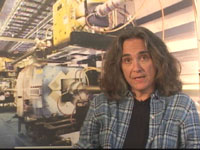The Birth of the Universe
What happened to the antimatter?

View the Video
Experiments teach us that for every fundamental particle there exists an antiparticle. The big bang and its aftermath almost certainly produced particles and antiparticles in equal numbers. However, for as far out in the universe as we can probe, our observations indicate that we live in a universe of matter, not antimatter. What happened to the antimatter? A tiny imbalance between particles and antiparticles must have developed early in the evolution of the universe, or it all would have annihilated, leaving only photons and neutrinos. Subtle asymmetries between matter and antimatter, some of which we have observed experimentally in the laboratory, must be responsible for this imbalance. But our current knowledge of these asymmetries is incomplete, insufficient to account for the observed matter domination.
There must be some other undiscovered phenomenon that makes matter and antimatter behave differently. We may discover it in quarks—or in neutrinos. Its source may lie in the properties of the Higgs boson, in supersymmetry or even in extra dimensions.
Tools for a scientific revolution
The Standard Model can accommodate the phenomenology of CP violation in quarks, because there are at least three generations of quarks; and because there is mixing between the quark flavors when they interact via the weak interaction. The CP violation measured in the B mesons at BaBar and Belle, along with a wealth of studies on quark flavor mixing over the past 20 years, are all consistent with this phenomenology. However current knowledge of CP violation is incomplete and insufficient by many orders of magnitude to account for the primordial matter-antimatter asymmetry of the universe. Present and planned accelerator experiments, including the LHCb experiment, are aimed at discovering other sources of CP violation that make matter and antimatter behave differently. It may appear in quarks-or in neutrinos. Its source may lie in the properties of the Higgs boson, in supersymmetry or even in extra dimensions.
CP violation in reactions that change the flavor of quarks is being measured with strange quarks (K meson decays) and bottom quarks (B meson decays). Ongoing and planned experiments include; BaBar at SLAC, Belle at KEK (Bd decay), and LHCb at CERN (Bd and Bs decay). Pinning down precisely the role of CP violation in the quarks is a critical step in solving the puzzle of the fate of primordial antimatter. Experiments have so far shown that, by itself, CP violation in quarks from flavor mixing in the Standard Model is probably not the sole source of the matter-antimatter asymmetry observed in the universe. Current and future B physics experiments will be sensitive to sources of CP violation beyond the Standard Model.
The discovery that neutrinos have mass opens up the search for CP violation in lepton reactions. Neutrino mass can, in principle, turn matter into antimatter and back, and can change the balance between them. Experiments are required to discover the role of neutrinos in the antimatter question. The MINOS experiment at Fermilab and reactor-based neutrino oscillation experiments will measure the parameters of neutrino oscillation. If the oscillation parameters are favorable, a neutrino superbeam facility with a large underground experiment will detect CP violation in neutrinos. Such a large detector, if sufficiently far underground, for example at a potential Deep Underground Science and Engineering Laboratory, could also serve as a next-generation proton-decay experiment.
- Last modified
- 04/28/2014
- email Fermilab

